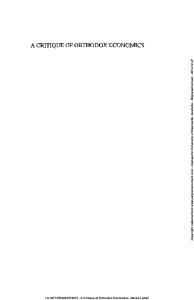A model of Austrian economics
After the most recent financial crisis it has become clear that there exists a crisis also in economics as a science. The prevailing paradigms have failed to anticipate and to understand the financial crisis. New approaches are therefore needed. Of partic
- PDF / 2,689,580 Bytes
- 104 Pages / 419.52 x 595.2 pts Page_size
- 2 Downloads / 360 Views
Hendrik Hagedorn
A model of Austrian economics
Hendrik Hagedorn Münster, Germany
Dissertation, Universität Münster, 2013 D6
ISBN 978-3-658-07076-2 DOI 10.1007/978-3-658-07077-9
ISBN 978-3-658-07077-9 (eBook)
The Deutsche Nationalbibliothek lists this publication in the Deutsche Nationalbibliografie; detailed bibliographic data are available in the Internet at http://dnb.d-nb.de. Library of Congress Control Number: 2014947964 Springer Gabler © Springer Fachmedien Wiesbaden 2015 This work is subject to copyright. All rights are reserved by the Publisher, whether the whole or part of the material is concerned, specifically the rights of translation, reprinting, reuse of illustrations, recitation, broadcasting, reproduction on microfilms or in any other physical way, and transmission or information storage and retrieval, electronic adaptation, computer software, or by similar or dissimilar methodology now known or hereafter developed. Exempted from this legal reservation are brief excerpts in connection with reviews or scholarly analysis or material supplied specifically for the purpose of being entered and executed on a computer system, for exclusive use by the purchaser of the work. Duplication of this publication or parts thereof is permitted only under the provisions of the Copyright Law of the Publisher’s location, in its current version, and permission for use must always be obtained from Springer. Permissions for use may be obtained through RightsLink at the Copyright Clearance Center. Violations are liable to prosecution under the respective Copyright Law. The use of general descriptive names, registered names, trademarks, service marks, etc. in this publication does not imply, even in the absence of a specific statement, that such names are exempt from the relevant protective laws and regulations and therefore free for general use. While the advice and information in this book are believed to be true and accurate at the date of publication, neither the authors nor the editors nor the publisher can accept any legal responsibility for any errors or omissions that may be made. The publisher makes no warranty, express or implied, with respect to the material contained herein. Printed on acid-free paper Springer Gabler is a brand of Springer DE. Springer DE is part of Springer Science+Business Media. www.springer-gabler.de
I would like to thank Prof. Hans Hermann Lechner, Prof. Ulrich van Suntum, Dr. Stefan Kooths, Dr. Pascal Seppecher, the Ludwig-von-Mises Institute, and my entire family. This work would not have been possible without their guidance and support. Moreover, I thank Adam Lederer and Alexander Malt for proofreading the manuscript and Hella Steinke for improving its layout.
Berlin, April 9, 2014 Hendrik Hagedorn
Contents
1
Introduction . . . . . . . . . . . . . . . . . . . . . . . . . . . . . . . . . . . . . . . . . . . . . . . . . .
1
2
The setup of the model . . . . . . . . . . . . . . . . . . . . . . . . . . . . . . . . . . . . . . . . . 2.1 A monetary market economy . . . . . . .
Data Loading...











